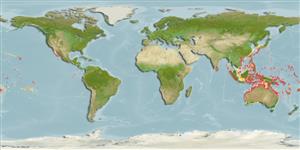Teleostei (teleosts) >
Perciformes/Scorpaenoidei (Scorpionfishes) >
Scorpaenidae (Scorpionfishes or rockfishes) > Scorpaeninae
Etymology: Scorpaenopsis: Latin, scorpaena = a kind of fish, 1706 + Greek, opsis = appearance (Ref. 45335).
More on author: Cuvier.
Environment: milieu / climate zone / depth range / distribution range
Ecology
Marine; brackish; reef-associated; depth range 1 - 40 m (Ref. 34765). Tropical
Pacific Ocean: Indonesia and the Philippines to the Society Islands, north to the Ryukyu Islands, south to the Great Barrier Reef and Fiji.
Size / Weight / Age
Maturity: Lm ? range ? - ? cm
Max length : 25.0 cm TL male/unsexed; (Ref. 34765); common length : 20.0 cm SL male/unsexed; (Ref. 37816)
Dorsal spines (total): 12; Dorsal soft rays (total): 9; Anal spines: 3; Anal soft rays: 5. Snout length > orbit diameter. Has a dark purplish blotch on the rear of the spinous dorsal fin (Ref. 37816). Juveniles with large, forward pointing tentacles above the eyes (Ref. 48635). Space on opercle between opercular spines scaled; penultimate dorsal spine 1.9-2.2 in length of last spine; reaches 195 mm SL (rarely over 170 mm) (Ref 42181).
Found in coral and rocky areas to depths over 40 m (Ref. 34765); also in coastal and slopes, estuaries and lagoons, often in algae covered rubble zones (Ref. 48635). Feeds on fishes (Ref. 89972). Solitary and difficult to see due to camouflage colors (Ref 90102).
Life cycle and mating behavior
Maturities | Reproduction | Spawnings | Egg(s) | Fecundities | Larvae
Myers, R.F., 1999. Micronesian reef fishes. A comprehensive guide to the coral reef fishes of Micronesia. Coral Graphics, Barrigada, Guam. 216 p. (Ref. 34765)
IUCN Red List Status (Ref. 130435)
Threat to humans
Harmless
Human uses
Tools
Special reports
Download XML
Internet sources
Estimates based on models
Preferred temperature (Ref.
123201): 24.6 - 28.9, mean 27.7 °C (based on 514 cells).
Phylogenetic diversity index (Ref.
82804): PD
50 = 0.5000 [Uniqueness, from 0.5 = low to 2.0 = high].
Bayesian length-weight: a=0.01259 (0.00606 - 0.02615), b=3.03 (2.86 - 3.20), in cm total length, based on LWR estimates for this (Sub)family-body shape (Ref.
93245).
Trophic level (Ref.
69278): 4.2 ±0.8 se; based on size and trophs of closest relatives
Resilience (Ref.
120179): Medium, minimum population doubling time 1.4 - 4.4 years (Preliminary K or Fecundity.).
Fishing Vulnerability (Ref.
59153): Low vulnerability (15 of 100).
Nutrients (Ref.
124155): Calcium = 61.1 [30.2, 123.8] mg/100g; Iron = 0.673 [0.349, 1.470] mg/100g; Protein = 18.3 [16.3, 20.3] %; Omega3 = 0.226 [0.096, 0.586] g/100g; Selenium = 25.4 [12.9, 59.8] μg/100g; VitaminA = 196 [64, 580] μg/100g; Zinc = 1.46 [0.99, 2.13] mg/100g (wet weight);
